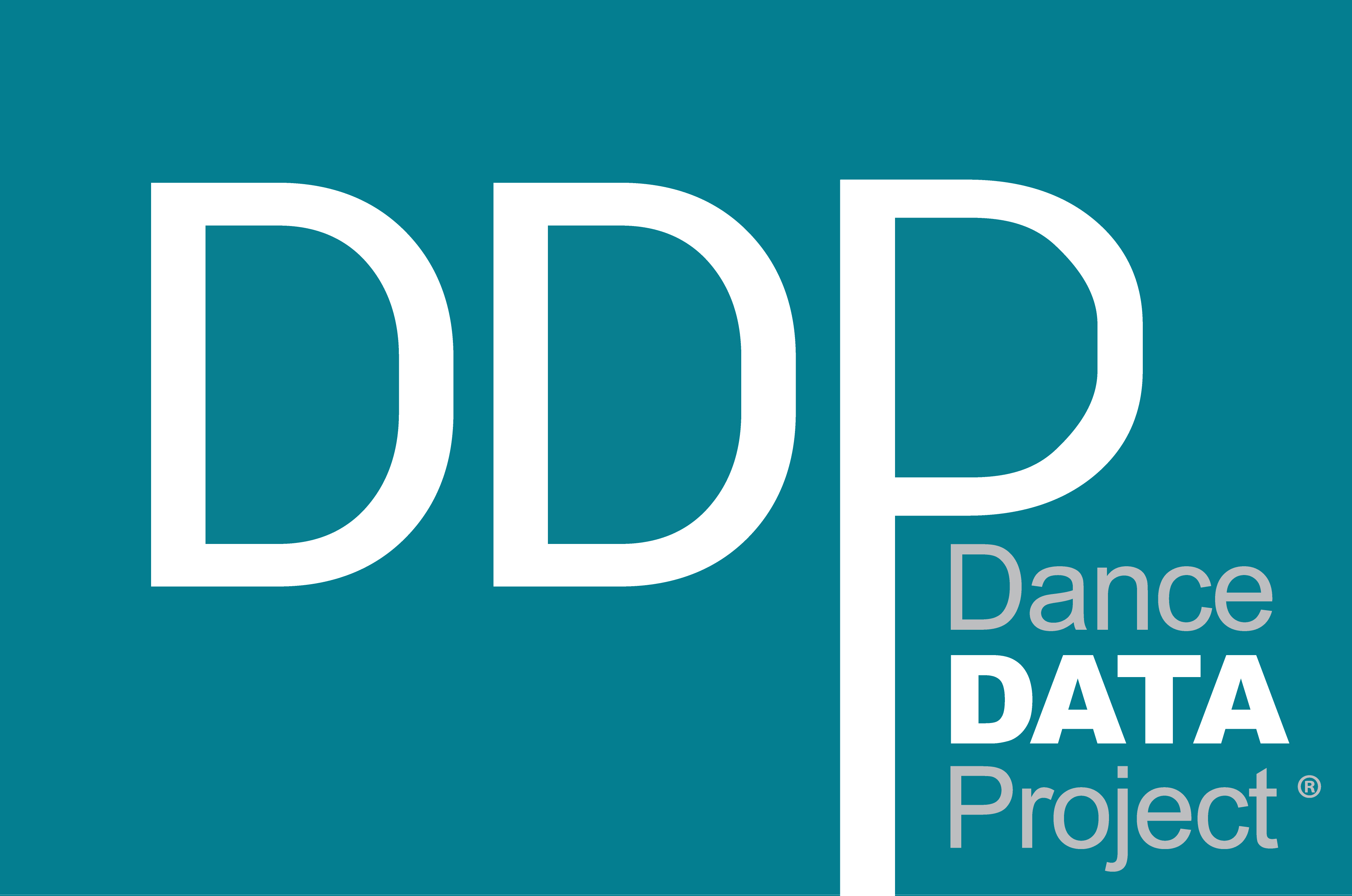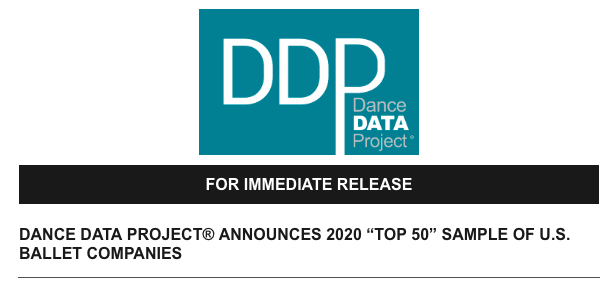March 2, 2020 | Northfield, IL Dance Data Project® today released the updated “Top 50” list of United States ballet companies, which will make up the sample of ballet companies studied by the research team for 2020 reports associated with ballet company repertoire and operations. DDP reviewed an IRS Business Master File of ballet organizations, classified by the National Taxonomy of Exempt Entities Core Code A63, in order to consider additional companies that operate in the industry.
DDP contacted the 74 companies with the opportunity to participate in the “Self-Report Survey,” a 10-minute survey consisting of seven items to report company revenues, expenses, and compensation of key employees (artistic and executive directors) for each company’s fiscal year ending in 2019. Responses were received from the following 15 companies:
- Alabama Ballet
- American Ballet Theatre
- Atlanta Ballet
- Ballet Arkansas
- BalletX
- Boston Ballet
- Charlotte Ballet
- Eugene Ballet
- Hubbard Street Dance Chicago
- Pacific Northwest Ballet
- PHILADANCO!
- Richmond Ballet
- San Francisco Ballet
- Smuin Ballet
- Tulsa Ballet
Information was also gathered from 14 annual reports, 15 financial audits, and 68 IRS Form 990s for the 74 companies that were available online. DDP located the financial audits and annual reports on company websites, while the Form 990s were downloaded through the ProPublica NonProfit Explorer. Because the majority of the companies in question had filed Form 990s (from the past three fiscal years) on ProPublica, DDP chose to classify the Top 50 based on the expenses reported in this document. The only exceptions to this rule were the 15 Self-Report Survey participants, which DDP ranked based on expenses reported in the Survey.
Below is DDP’s 2020 list of Top 50 U.S. ballet companies:
- New York City Ballet
- San Francisco Ballet
- American Ballet Theatre
- Alvin Ailey American Dance Theater
- Boston Ballet
- Houston Ballet
- Pacific Northwest Ballet
- Joffrey Ballet
- Miami City Ballet
- Pennsylvania Ballet
- Ballet West
- Atlanta Ballet
- The Washington Ballet
- Pittsburgh Ballet Theatre
- Cincinnati Ballet
- Kansas City Ballet
- Texas Ballet Theater
- Ballet Austin
- Colorado Ballet
- Nashville Ballet
- Ballet Arizona
- Charlotte Ballet
- Oregon Ballet Theatre
- Tulsa Ballet
- Milwaukee Ballet
- The Sarasota Ballet
- Hubbard Street Dance Chicago
- Ballet Hispánico
- BalletMet
- Richmond Ballet
- Carolina Ballet
- Dance Theatre of Harlem
- Orlando Ballet
- Alonzo King LINES Ballet
- Ballet Memphis
- Nevada Ballet Theatre
- Aspen Santa Fe Ballet
- Louisville Ballet
- American Repertory Ballet
- Smuin Ballet
- Oklahoma City Ballet
- Los Angeles Ballet
- Sacramento Ballet
- Grand Rapids Ballet
- BalletX
- LA Dance Project
- California Ballet
- Eugene Ballet
- Alabama Ballet
- Ballet Idaho
Download the complete ranking, with expenses and fiscal years detailed here.
Please note that companies on the list previously, Dayton Ballet and Jose Mateo Ballet Theatre (JMBT), did not meet classifications for the Top 50 in 2020 due to (1) clarified expenses for Dayton Ballet via the Self-Report Survey (the company operates as an entity within the Dayton Performing Arts Alliance) and (2), in the case of JMBT, operation primarily as a ballet school. To inquire about sources, operational definitions, or further classifications for the Top 50, please contact Isabelle Vail, DDP Director of Research, at ivail@dancedataproject.com.
Operational Definition of “Ballet Company”
For the purposes of study, DDP defines “ballet company” as a nonprofit dance company that has roots in classical dance. The art form, however, is clearly evolving, incorporating tap dance (see Michelle Dorrance at American Ballet Theatre) as well as hip hop (see Lil Buck at Vail Dance Festival), a natural and welcome evolution or cross pollination. DDP has considered many factors in the formation of our operational definition, including the definition of “ballet” provided by our friends at the NYU Center for Ballet and the Arts, who define it simply as “to dance” or “a form of poetic gesture.”
Three companies on DDP’s Top 50 list do not have “ballet” in their name: Alvin Ailey American Dance Theater, Hubbard Street Dance Chicago, and LA Dance Project. DDP includes these three companies because of their employment in the past or present of a resident choreographer and/or artistic director who is or has been commissioned or engaged in some way at other traditional ballet companies. For example, Alejandro Cerrudo, named the first Resident Choreographer at Pacific Northwest Ballet (PNB) and Robyn Mineko Williams, another choreographer associated with the company, have each had their starts with Hubbard Street Dance Chicago. Penny Saunders, too, Resident Choreographer at Grand Rapids Ballet, received early support from Hubbard Street. Kyle Abraham received a significant commission from Alvin Ailey American Dance Theater in 2016 and has similarly been commissioned by New York City Ballet and ballerina Misty Copeland. Finally, LA Dance Project’s founder and Artistic Director, Benjamin Millepied, served as Director of the Paris Opera Ballet for three seasons and was classically trained by the School of American Ballet.
DDP will consider and study more companies in the future and encourages companies to submit information directly to the research team for more accurate metrics. Our research would not be possible without the support of our ally companies and leaders. We would therefore like to extend a special thanks to the 15 respondents of our Self-Report Survey, who have demonstrated meaningful commitment to equity through their participation, as well as to the leaders at various organizations who assisted our team in forming an operational definition of “ballet.”
DDP will continue its research in late March with the release of the “2020 Executive and Artistic Leadership Report,” an examination of equity in the salaries of the Top 50’s leaders.





